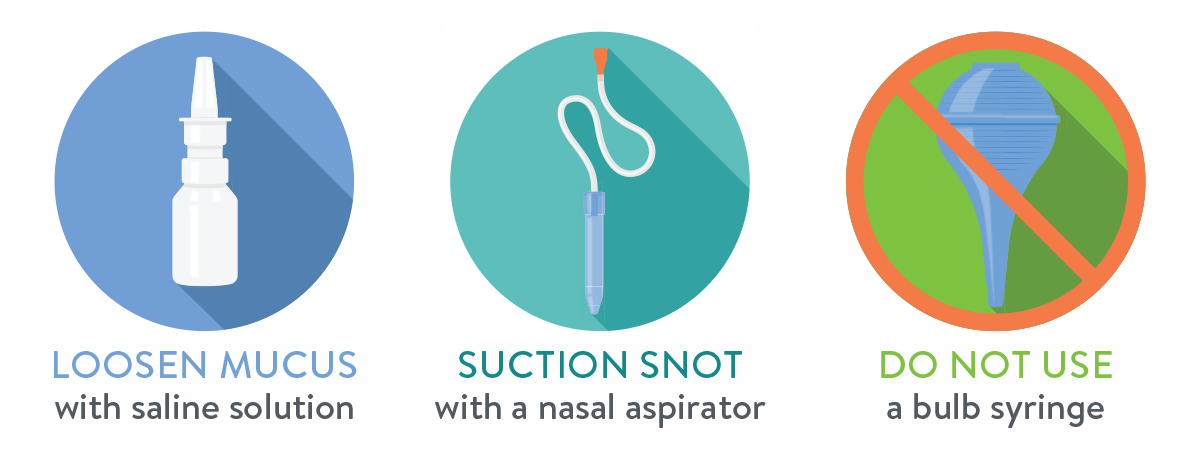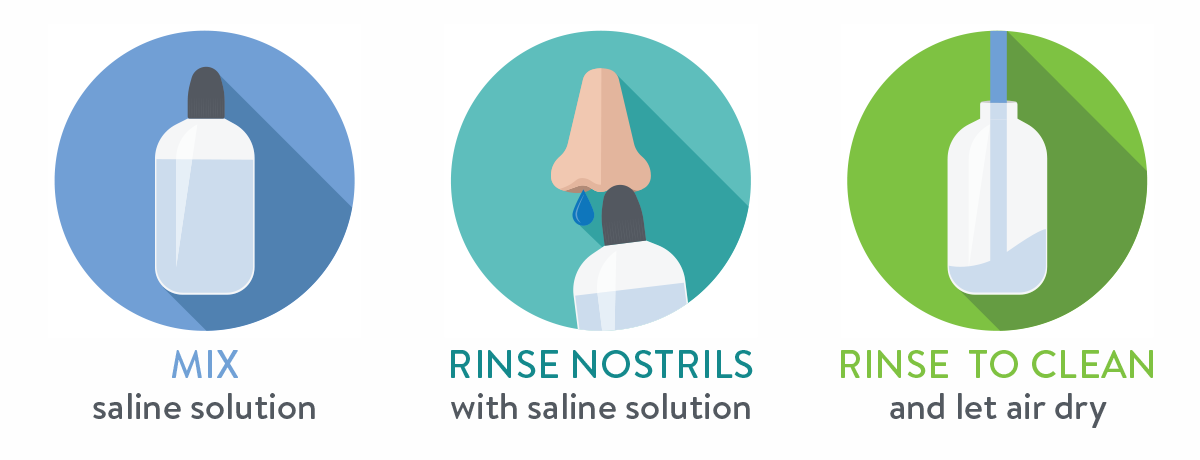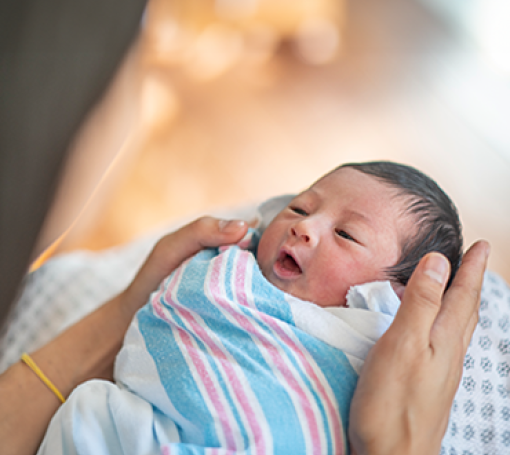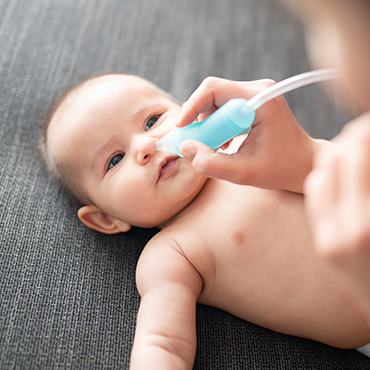Nasal Suctioning

When is nasal suctioning needed?
Infants are born with small noses. When they catch a cold, a small amount of mucus can easily plug their nasal passages. Because babies don’t yet know how to blow their nose, a plugged nose can affect their ability to eat, sleep, or breathe normally. Babies develop thick sticky mucus more often than a runny nose. If mucus is clear and self-draining, then you only need to use a gentle cloth to wipe their face. However, when mucus is thick and sticky, babies need help to clear their noses.
What is the best method for nasal suctioning?
Begin by carefully resting your baby on a blanket for comfort.
Saline drops/spray: Use a nasal saline rinse to help loosen mucus in the nostrils. These are available in drop or spray bottles. Saline rinse can be purchased or made at home by mixing a quarter teaspoon of salt with one cup of clean, warm water (no well water).
- Drops: Use 3+ drops per side (no more than 10)
- Spray: Use enough to “hose” off the sticky mucus
Suction: You can then suction out the saline and mucus using a nasal aspirator. The baby will swallow or snort out any additional mucus and saline. Swallowing the saline will not harm your baby. Always clean the aspirator thoroughly after use.
What is a nasal aspirator?
A nasal aspirator is a small suction device that is specifically designed to remove mucus from a baby’s nose. There are both human suction aspirators and electric nasal aspirators available.
Human suction aspirators: These work by placing a small tube at the edge of the baby’s nostril to create a gentle seal and a mouthpiece and filter at the other end of the tube. The adult can then use the mouthpiece to suck the mucus out themselves, manually. These aspirators offer control over the force used to suction the mucus.
Electric nasal aspirators: These are similar to the device mentioned above but they are powered by electricity. They can be used if a parent or caregiver is not comfortable using their mouth for suction. The downsides to this version are that they don’t offer as much control over the force that is or is not needed to suction and they are quite expensive.
Can I use a bulb syringe?
We no longer recommend using bulb syringes. Their shape does not allow a seal to be created in the nostril, so suction will have to be stronger than a nasal aspirator. More importantly, you cannot see the bulb tip inside a baby’s nose, so if they move their heads, it is too easy to cause damage to their tiny nostril.
Nasal Irrigation

How can my child clear their nose after outgrowing a nasal aspirator?
Keeping your child’s nose clear during illness is important even after they outgrow a nasal aspirator. Most kids no longer tolerate the nasal aspirator by 2-3 years old. When this happens, begin to teach your toddler how to blow their nose by showing them how to blow bubbles with their nose under water in the bathtub. You can also begin teaching them how to use saline irrigation to remove thick mucus.
What is saline irrigation and when is it needed?
Saline irrigation is the process of using saline solution and a squirt bottle to wash mucus and irritants from the nasal passages. It can be difficult for your child to blow all of the mucus out of their nose. Mucus can remain in the back of their nose and drip down their throat causing them to cough. A great way to help clear out this mucus is to use saline irrigation.
What is the best method for saline irrigation?
Saline irrigation is best taught by using saline solution and a squirt bottle. Nasal rinse squirt bottles can be purchased at most grocery stores, pharmacies, or online. They do make kid-sized squirt bottles, but they are often hard to find and more expensive, and therefore not necessary. Adult-sized bottles are safe to use on children.
- Begin by making saline solution (1 cup of water + 0.5 tsp non-iodized salt + 0.5 tsp baking soda) or use premixed saline packets that are sold cheaply at most stores and mix with the recommended amount of water.
- Never use well-water to make saline solution; always use clean tap, boiled, or bottled water
- Body temperature water is best; hot/cold water are uncomfortable and can cause dizziness
- Allow your child to play with the squirt bottle in the bathtub so they are not afraid or demonstrate showing them how you squirt your nose using your own squirt bottle. Make it fun! If your child is older, allow them to use the squirt bottle themselves. Giving them control can make it feel less scary.
- Have your child lean forward so saline goes in one nostril and out the other. For younger children, we recommend wrapping them in their towel after a bath and leaning them over the side of the tub. Older children can stand and lean forward over the sink. If they are upright or leaning back, saline will come out of their mouth and be very unpleasant.
- Your child may only tolerate one squirt in one nostril at first. Celebrate what they do tolerate and work up to clearing each nostril over time.
- Some saline may drip out of the nose in a delayed fashion. This is normal and is safe to swallow.
- Finally, rinse the squirt bottle with warm water and set it upside down to dry after use. If you do not do this, you risk mucus sticking to the side and becoming hard to clean or growing mold (then you have to replace your squirt bottle).
Other helpful tips:
- If your child has any ear pain, it is best to plug the nose and blow first (think clearing your ears on the airplane) to open the inner ear tubes. This allows the mucus to be rinsed out instead of creating pressure against an already full tube.
- Do not share squirt bottles. Each person in the family should have their own to prevent the spread of germs.
- Like the nasal aspirator, nobody loves rinsing their nose. The best time to use is right before bed so you and your child can sleep for hours before they make more mucus.
Keep Reading
View All Posts
The Importance of Routine Childhood Vaccines: What Families Need to Know
Staying informed and protected with Allegro Pediatrics.

Helping Kids Breathe Easier
By checking asthma control at every well care visit, we can identify changes early and make sure each child has the support they need to breathe comfortably and stay active.

Protecting Your Newborn from Hepatitis B
Learn why the birth dose of the hepatitis B vaccine matters for every baby.

